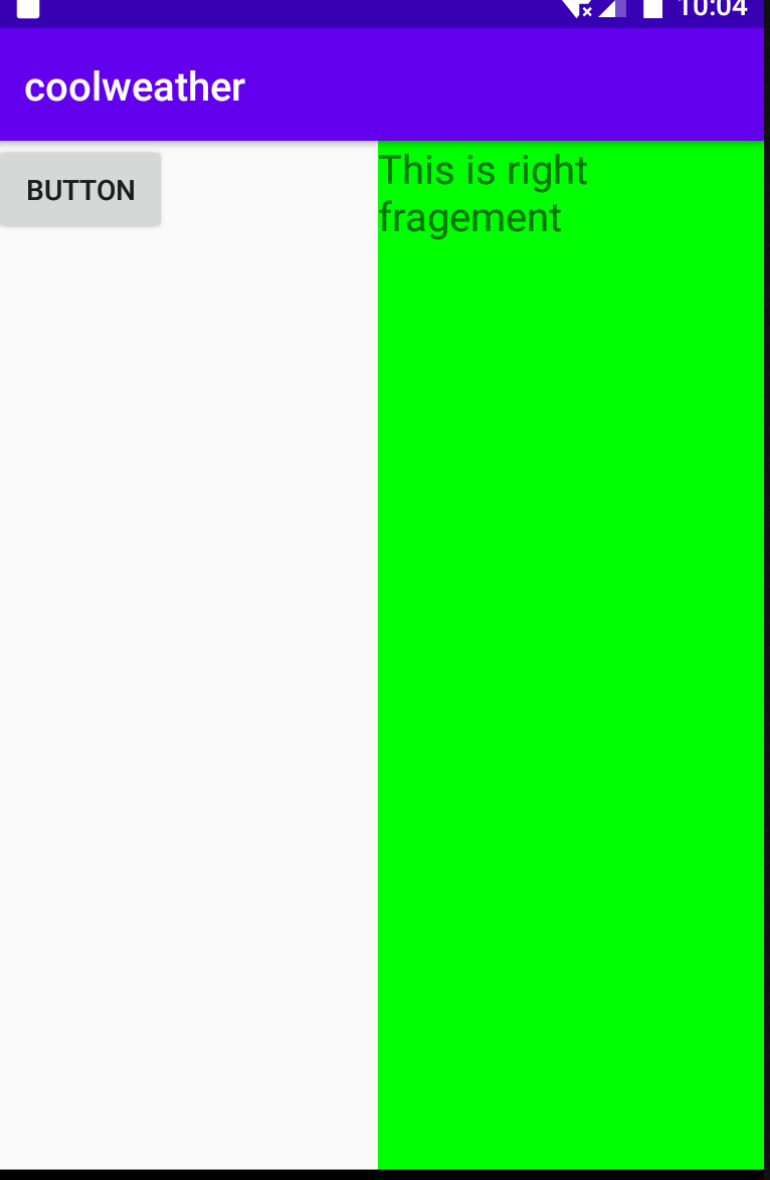安卓开发--探究碎片Fragment
简述:
最近做开发的时候又遇到了Fragment,发现太久没写,都快忘了,就抓紧写个笔记(我太懒的了233)
Fragment可以简单的看成迷你的活动,它和活动一样都有布局和生命周期,它可以嵌入活动之中,
这样在活动的这个大布局中,还可以嵌入碎片的布局,那么app的功能就可以多样化,实现碎片的方式也
很简单,因为碎片是个迷你的活动,那么肯定得和活动一样,搭配一个布局文件,所以做法是先创建
对应碎片的布局文件,然后新建碎片类继承Fragment类,把碎片布局加载进来,然后再把这个碎片
加载到对应我们想要嵌入的活动中,因为碎片表现形式还是布局,所以我们是在活动的布局文件中
加入碎片,加载碎片的。
0x01:简单使用
新建两个布局文件,Left_fragment和Right_fragment.xml,
<?xml version="1.0" encoding="utf-8"?>
<LinearLayout xmlns:android="http://schemas.android.com/apk/res/android"
android:layout_width="match_parent"
android:layout_height="match_parent">
<Button
android:layout_width="wrap_content"
android:layout_height="wrap_content"
android:id="@+id/button"
android:layout_gravity="center_horizontal"
android:text="Button"/> </LinearLayout>
<?xml version="1.0" encoding="utf-8"?>
<LinearLayout xmlns:android="http://schemas.android.com/apk/res/android"
android:orientation="vertical"
android:background="#00ff00"
android:layout_width="match_parent"
android:layout_height="match_parent">
<TextView
android:layout_width="wrap_content"
android:layout_height="wrap_content"
android:layout_gravity="center_horizontal"
android:textSize="20sp"
android:text="This is right fragement"/> </LinearLayout>
然后新建两个碎片类,继承Fragment,
package com.example.coolweather; import android.os.Bundle;
import android.view.LayoutInflater;
import android.view.View;
import android.view.ViewGroup; import androidx.fragment.app.Fragment; public class LeftFragment extends Fragment {
public View onCreateView(LayoutInflater inflater, ViewGroup container, Bundle saveInstanceState)
{
View view=inflater.inflate(R.layout.left_fragment,container,false);
return view;
}
}
package com.example.coolweather; import android.os.Bundle;
import android.view.LayoutInflater;
import android.view.View;
import android.view.ViewGroup; import androidx.fragment.app.Fragment; public class RightFragment extends Fragment {
public View onCreateView(LayoutInflater inflater, ViewGroup container, Bundle savedInstanceState)
{
View view =inflater.inflate(R.layout.right_fragment,container,false);
return view;
}
}
重写一个Fragment类中的onCreateView方法,通过inflater.inflate加载碎片的布局,
然后最后就是将碎片嵌入到我们想要的活动之中(以布局的形式,所以还是在xml文件中加入)
<?xml version="1.0" encoding="utf-8"?>
<LinearLayout xmlns:android="http://schemas.android.com/apk/res/android"
android:layout_width="match_parent"
android:layout_height="match_parent"> <fragment
android:id="@+id/left_fragment"
android:name="com.example.coolweather.LeftFragment"
android:layout_width="0dp"
android:layout_weight="1"
android:layout_height="match_parent" />
<fragment
android:layout_width="0dp"
android:layout_height="match_parent"
android:layout_weight="1"
android:id="@+id/right_fragment"
android:name="com.example.coolweather.RightFragment"
/>
</LinearLayout>
然后打开模拟器就可以看到对应的效果了。

二.动态添加碎片,
新建另一个碎片布局文件,并创建碎片类,加载碎片布局
<?xml version="1.0" encoding="utf-8"?>
<LinearLayout xmlns:android="http://schemas.android.com/apk/res/android"
android:layout_width="match_parent"
android:orientation="vertical"
android:background="#ffff00"
android:layout_height="match_parent">
<TextView
android:layout_width="wrap_content"
android:layout_height="wrap_content"
android:layout_gravity="center_horizontal"
android:textSize="20sp"
android:text="This is another right fragment"
/>
</LinearLayout>
package com.example.coolweather; import androidx.appcompat.app.AppCompatActivity;
import androidx.fragment.app.Fragment;
import androidx.fragment.app.FragmentManager;
import androidx.fragment.app.FragmentTransaction; import android.content.Intent;
import android.os.Bundle;
import android.view.View;
import android.widget.Button; import java.nio.channels.InterruptedByTimeoutException; public class MainActivity extends AppCompatActivity { @Override
protected void onCreate(Bundle savedInstanceState) {
super.onCreate(savedInstanceState);
setContentView(R.layout.layout);
Button button=(Button)findViewById(R.id.button);
button.setOnClickListener((View.OnClickListener) this); }
public void onClick(View v)
{
switch(v.getId()) {
case R.id.button:
replaceFragment(new AnotherRightFragment());
break;
default:
}
}
private void replaceFragment(Fragment fragment)
{
FragmentManager fragmentManager=getSupportFragmentManager();
FragmentTransaction transaction=fragmentManager.beginTransaction();
transaction.replace(R.id.right_layout,fragment);
transaction.commit();
}
}
replacefFragment这个方法是动态加载碎片的关键,先是调用getSupportFragmentManager()这个方法
返回FragmentManager对象,再通过FragManager对象调用beginTransaction开启事务,然后调用
replace方法,第一个参数是容器的id,第二个参数是碎片的实例,就可以了,运行代码就有效果出现了。
另外如果需要点击back按钮返回到上一个碎片的,话要额外再加一句代码,在replaceFragment中多加
一句就好了。
private void replaceFragment(Fragment fragment)
{
FragmentManager fragmentManager=getSupportFragmentManager();
FragmentTransaction transaction=fragmentManager.beginTransaction();
transaction.replace(R.id.right_layout,fragment);
transaction.addToBackStack(null)
transaction.commit();
}
安卓开发--探究碎片Fragment的更多相关文章
- 安卓开发笔记——Fragment+FragmentTabHost组件(实现新浪微博底部菜单)
记得之前写过2篇关于底部菜单的实现,由于使用的是过时的TabHost类,虽然一样可以实现我们想要的效果,但作为学习,还是需要来了解下这个新引入类FragmentTabHost 之前2篇文章的链接: 安 ...
- 安卓开发笔记——Fragment+ViewPager组件(高仿微信界面)
什么是ViewPager? 关于ViewPager的介绍和使用,在之前我写过一篇相关的文章<安卓开发复习笔记——ViewPager组件(仿微信引导界面)>,不清楚的朋友可以看看,这里就不再 ...
- Android开发:碎片Fragment完全解析fragment_main.xml/activity_main.xml
Android开发:碎片Fragment完全解析 为了让界面可以在平板上更好地展示,Android在3.0版本引入了Fragment(碎片)功能,它非常类似于Activity,可以像 Activi ...
- 学习安卓开发[2] - 在Activity中托管Fragment
目录 在上一篇学习安卓开发[1]-程序结构.Activity生命周期及页面通信中,学习了Activity的一些基础应用,基于这些知识,可以构建一些简单的APP了,但这还远远不够,本节会学习如何使用Ac ...
- 安卓Android碎片fragment实现静态加载
静态加载好后的界面如下,两个碎片分别位于一个活动的左边和右边: 左边和右边分别为一个碎片,这两个碎片正好将一整个活动布满.一个活动当中可以拥有多个碎片,碎片的含义就是可以在同一个UI界面下,将这个界面 ...
- 安卓开发_浅谈Fragment之ListFragment
ListFragment,即Fragment的一个子类,当我们用的一个Fragment只需要一个listview视图的时候使用 该类有几个特点: 1.ListFragment 本身具只有一个ListV ...
- Android利用碎片fragment实现底部标题栏(Github模板开源)
在安卓开发当中,一个十分重要的布局则是底部标题栏了,拥有了底部标题栏,我们就拥有了整个软件UI开发的框架,一般而言,整个软件的布局首先就是从底部标题栏开始构建,然后再开始其他模块的编写,组成一个完善的 ...
- 从0系统学Android--4.1探究碎片
从0系统学Android--4.1探究碎片 本系列文章目录:更多精品文章分类 本系列持续更新中.... 初级阶段内容参考<第一行代码> 第四章:手机平板要兼顾--探究碎片 平板电脑和手机最 ...
- 安卓开发_深入学习ViewPager控件
一.概述 ViewPager是android扩展包v4包(android.support.v4.view.ViewPager)中的类,这个类可以让用户左右切换当前的view. ViewPager特点: ...
随机推荐
- ioctl 函数的FIOREAD参数
在学习ioctl 时常常跟 read, write 混淆.其实 ioctl 是用来设置硬件控制寄存器,或者读取硬件状态寄存器的数值之类的. 而read,write 是把数据丢入缓冲区,硬件的驱动从缓冲 ...
- 重新整理 .net core 实践篇————依赖注入应用之生命法则[三]
前言 该章演示依赖注入中,对象的释放行为. 紧接上文表示,演示: services.AddSingleton<IMySingletonService, MySingletonService> ...
- 利用MathType快速提取论文中的公式
首先随便打开一个论文,比如下图,我们想提取公式(2.2.7) 第一步:按截图快捷键:Win+Shift+S ,把公式截取下来 第二步:打开大佬开发的网站:https://mathf.itewqq.cn ...
- JAVA并发(3)-ReentrantReadWriteLock的探索
1. 介绍 本文我们继续探究使用AQS的子类ReentrantReadWriteLock(读写锁).老规矩,先贴一下类图 ReentrantReadWriteLock这个类包含读锁和写锁,这两种锁都存 ...
- java并发编程工具类JUC第一篇:BlockingQueue阻塞队列
Java BlockingQueue接口java.util.concurrent.BlockingQueue表示一个可以存取元素,并且线程安全的队列.换句话说,当多线程同时从 JavaBlocking ...
- 微信小程序setdata修改数组或对象
1.this.setdata修改数组的固定一项的值 changeItemInArr: function() { this.setData({ 'arr[0].text':'changed data' ...
- [LeetCode] 1074. 元素和为目标值的子矩阵数量
矩阵前缀和.因为矩阵中可能包含负值,所以这题肯定不会存在什么剪枝,动态规划的可能性.所以这个题也就没什么弯弯绕绕.个人感觉算不上个Hard题目. 最直观的思路就是枚举子矩阵,既枚举矩阵的左上角节点和右 ...
- AIoT开放平台及应用
AIoT开放平台及应用 阿里AIoT开放平台,是阿里云IoT面向开发者的能力接入渠道,开发者可以在这里完成能力的申请.开通.部署.配置和集成开发等一些列工作.这些能力并不的独立交付,而是通过关联到行业 ...
- MindSpore技术理解(下)
MindSpore技术理解(下) 4 GraphEngine 由于深度学习算法需要进行大量的计算,很多公司都设计了自己的深度学习专用处理器(如谷歌的张量处理器.阿里巴巴的含光等),华为也发布了自主设计 ...
- GPU编程和流式多处理器(三)
GPU编程和流式多处理器(三) 3. Floating-Point Support 快速的本机浮点硬件是GPU的存在理由,并且在许多方面,它们在浮点实现方面都等于或优于CPU.全速支持异常可以根据每条 ...
